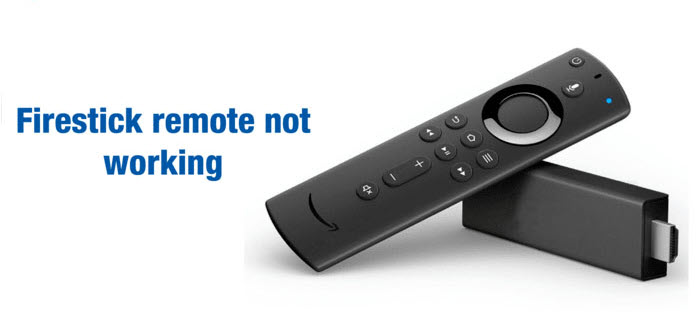Bypass the Netflix Password Sharing Ban: A Comprehensive Guide
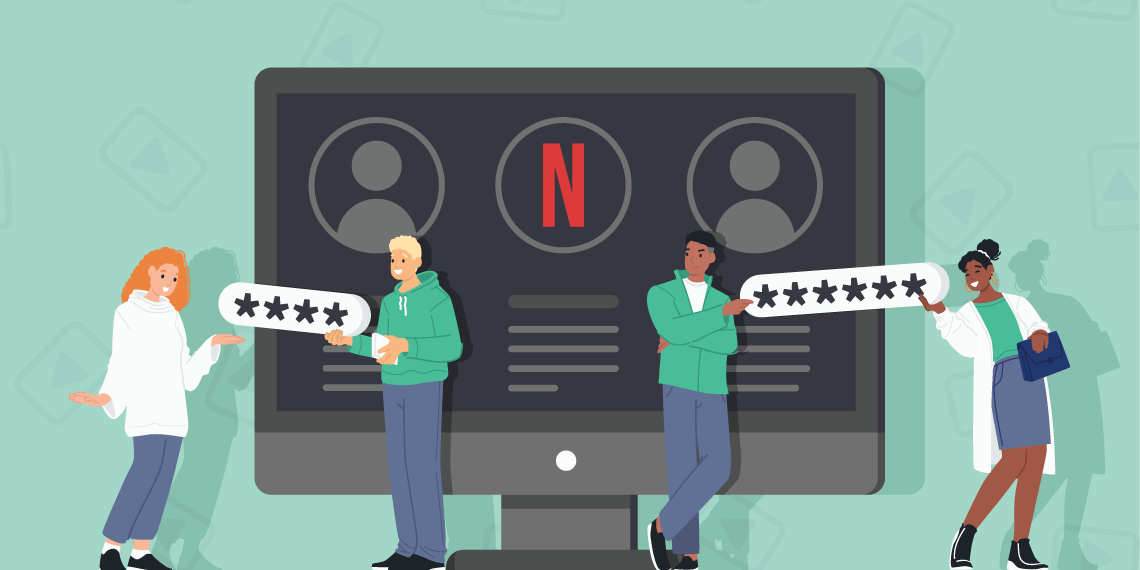
Netflix password-sharing has come to an end. From now on, people need to live in the same location to keep sharing an account for free. Otherwise, users outside of the “Netflix Household” will need to pay an additional fee.
So, does this mean you can’t use a family member’s account anymore? Not necessarily. If you can change your IP address to the IP address of the account owner, you can get around this policy. We discuss this in detail below.
How to Get Around Netflix’s Account Sharing Restriction
Do you keep getting a “This TV isn’t part of your Netflix Household” error? If so, then Netflix is cracking down on password sharing in your country.
To bypass this, it’s important to understand how Netflix enforces its account-sharing restriction. First, the app will note your household’s IP address. Next, it will block users that don’t connect to that household IP address at least once a month.
We looked into what methods subscribers have been using to try and bypass the ban. The solution is pretty obvious: connect to your home IP address remotely. We detail the steps below.
NOTE: Streaming services like Netflix might not appreciate you circumventing its password sharing restrictions. Our guide is for informational purposes, and we advise against doing anything that will breach your user agreement with Netflix.
1. Subscribe to a VPN with Meshnet technology
Meshnet is a great technology that can help connect devices remotely. It can be used for sharing an IP address, as well as sharing files seamlessly or appearing connected on a LAN for online gaming.
Any VPN that offers Meshnet is a good choice for circumventing Netflix’s account-sharing restrictions. However, in our experience, NordVPN is by far the best choice.
NordVPN offers seamless Meshnet connections. It only takes a few minutes to set everything up, and then you can connect to the same network as your household.
NordVPN is also our top choice for streaming. Its fast servers ensure that you don’t have to suffer through endless buffering, and its wide server network grants access to all kinds of international Netflix libraries.
What’s more, NordVPN’s obfuscated servers allow you to hide your VPN use from streaming sites, so they can’t tell that you’re using a VPN for streaming. Find out more about NordVPN by clicking the button below.
In theory, you can use any VPN to bypass the password-sharing ban. You just need to connect all of your devices to the same IP address.
However, you’d have to use Netflix on the same VPN server every single time, which can get inconvenient. So, our official recommendation is to use a VPN with Meshnet (or similar technology).
2. Install the VPN on your devices
After you’ve subscribed to a VPN service, download the VPN app on 1) a device in your household and 2) the device you’ll be using to watch Netflix remotely.
Installing NordVPN is easy. The app is available on a lot of devices, and you’ll get a download link right after you sign up. Just pick the download file for your device and go through the installation process. Here’s an example of what the installation wizard might look like on Windows.
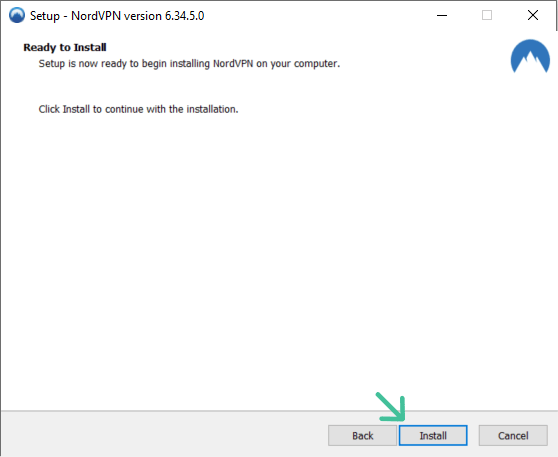
Again, don’t forget to go through this process on two devices: one in your household and one that you plan to use remotely (like a laptop, phone, or tablet).
If you’re not home right now, you can ask someone to install NordVPN on any device in your household. We recommend the device be a macOS or Windows device. Not all devices are capable of acting as a Meshnet host, so it’s safest to stick with a laptop or desktop.
3. Turn on Meshnet on your household device
Enabling Meshnet on your home device will allow you to use your household’s IP address as if you were physically there. Here’s how to turn it on:
- Open the NordVPN app from a device connected to your household network.

- Open the Meshnet tab. It’s the second one right below the main interface.
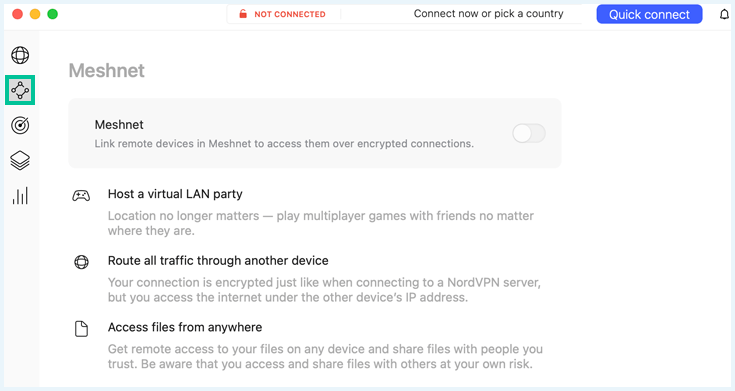
- Enable a Meshnet connection on your device by toggling the slider next to “Meshnet.” This is what you would see on a Mac if successful:
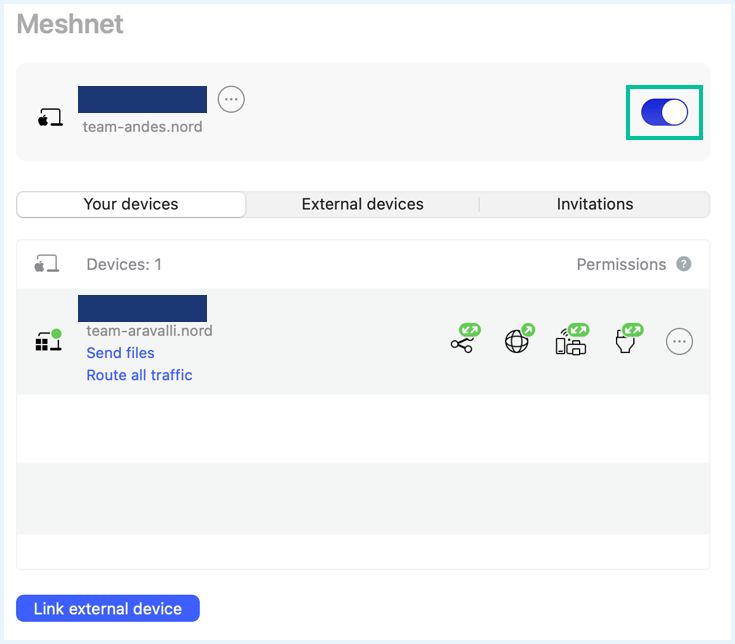
- Make a note of the name at the top. In our case, that’s “team-andes.nord.” This is what you’ll want to connect to from your remote device.
Again, it’s best to do this on a Windows PC or a macOS-powered device. And if you use macOS, make sure you install NordVPN from the developer’s site, not the App Store. The latter version can’t act as a Meshnet host.
4. Connect to the new network from remote devices
If you’ve completed the previous step, you can now connect to your household IP address from anywhere in the world. Here’s a quick guide on how to do that:
- Open NordVPN from any device that’s not connected to your household IP address.
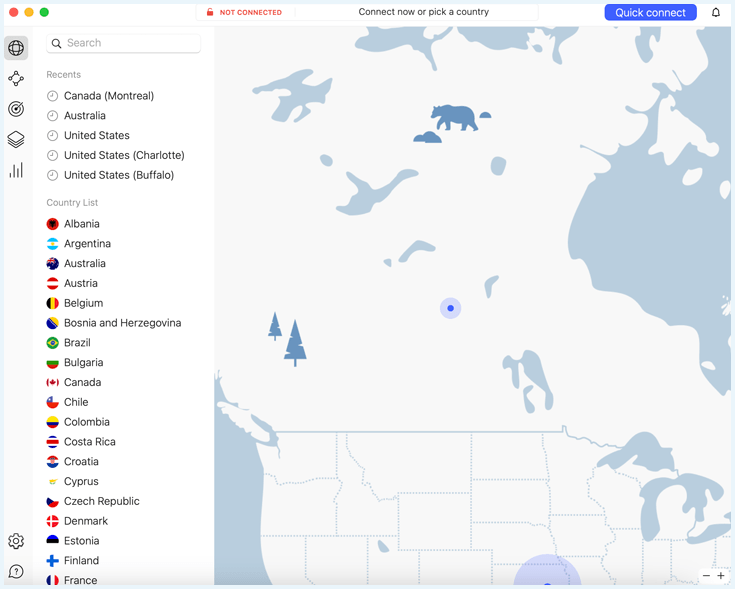
- Open the Meshnet tab.

- Turn Meshnet on and scroll down to “Your devices.”
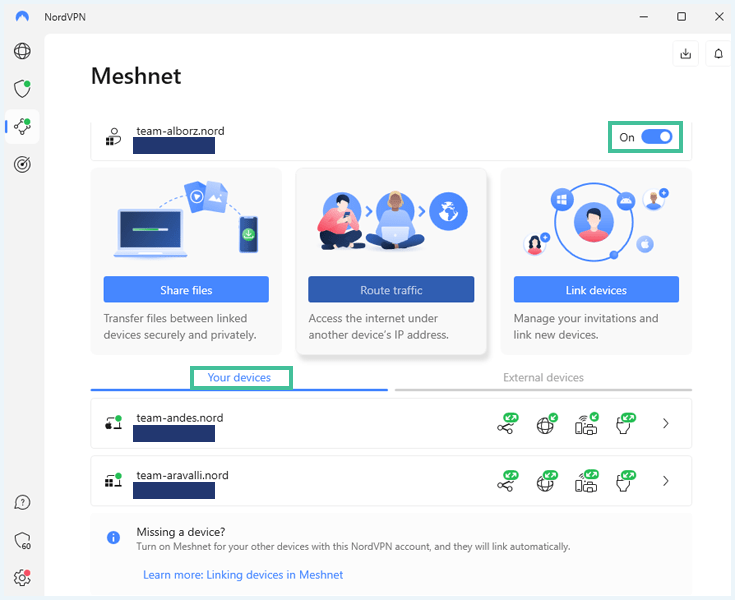
- Click on “Route all traffic” next to the household connection that you wrote down earlier.

That’s it! You are now using your household’s IP address.
You can stop routing your traffic through this network at any point by clicking the “Stop routing traffic” button.

Technically, you can do all of this without being connected to the same NordVPN account. From your household connection, you can invite external devices to join your Meshnet. There are detailed guides from NordVPN on how to do this. However, the method we outlined above is the fastest one.
5. Watch Netflix worldwide
If you did everything correctly, you should now be able to access Netflix worldwide without worrying about traveling back to your household.

Just don’t forget to log into the Meshnet connection at least once a month to avoid your access being terminated by Netflix.
And remember, you can do a lot more with your Meshnet connection. You can play games with the host device as if you’re on the same LAN connection, and you can even share files with one another.
Why is Netflix Restricting Password Sharing?
Netflix has been testing means to restrict sharing accounts for a while now. The reason is pretty simple: if five people are using Netflix but only the account holder is paying for it, then the streaming company is only making one-fifth of the money it could be making. So by limiting account sharing, Netflix can secure more revenue.
The company deployed this change in policy in select regions over the past year and only recently chose to extend it to other countries. Paying subscribers received an email detailing the change, as seen below.
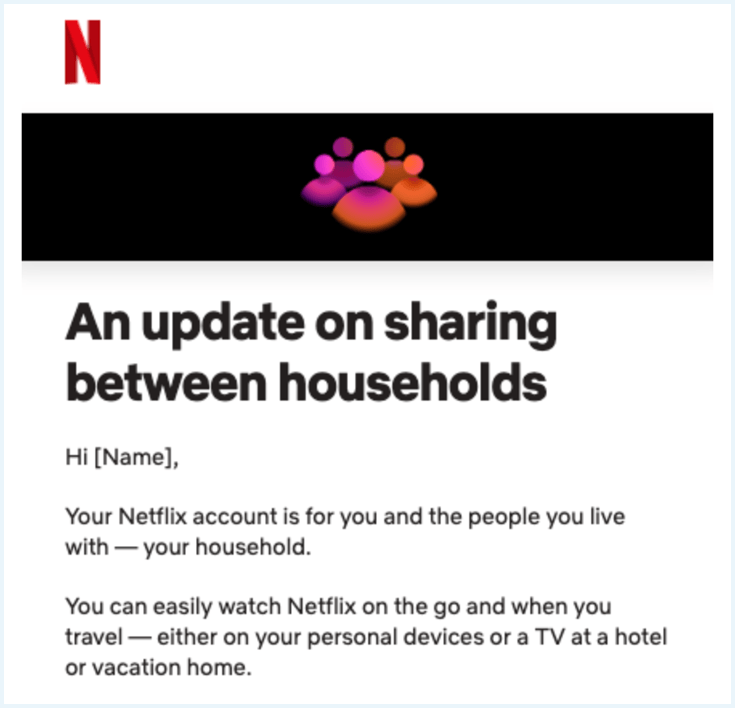
How does Netflix know when I share my account?
Netflix has several means of knowing if you share your account. When you connect to Netflix servers (i.e., whenever you open their site or app), Netflix gets a ton of information about you. This includes your account activity, device IDs, your browser fingerprint, and your IP address. They use this information to piece together where you are and whether or not you’re in the household of the primary account holder.
Its method is pretty simple. The first time you connect a smart TV to an account that TV’s network is designated as the “household” network. Thereafter, all devices will need to connect to said network at least once every 31 days. In theory, you can watch Netflix from different IP addresses — you just need to share the same internet connection as the account owner once in a while.
You may notice that this enforcement relies on connecting to Netflix via smart TVs. We can’t guarantee this, but for the moment, it seems that users can avoid the Netflix password-sharing restriction by just not logging in from a smart TV and thus not setting up a home connection. However, it’s unclear whether this will work in the long term.
Which countries are affected by the Netflix password-sharing restrictions?
As of late May 2023, over 100 countries are affected by the Netflix password-sharing crackdown. Restricted regions include the US, Canada, the UK, Latin America, Australia, most countries in Europe, and a slew more. Although the password-sharing restrictions have only been tested in Latin America over the last year, they’ve now been extended globally.
Netflix subscribers all across the globe have expressed discontent over Netflix’s password-sharing crackdown, especially given its older attempts at securing a higher market share by encouraging password-sharing.
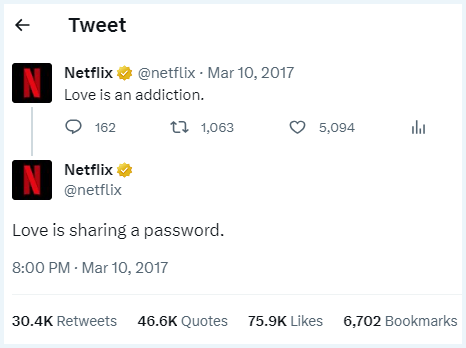
However, for now, Netflix seems unfazed by the backlash.
Who is negatively impacted by the password-sharing ban?
A lot of Netflix users are negatively impacted by this policy. There are a lot of family members that share an account but don’t live in the same physical household. For example, divorced parents, families with caretakers in different locations, students living away from home, and a lot more people could lose access to their favorite entertainment platform because of the policy change.
Granted, Netflix has offered an alternative in the form of paying extra for users outside of the household. However, its new policy doesn’t seem to cover crucial situations where family members might not be able to share a “Netflix household.” For instance, if your kid went away for college and can’t return home every 31 days, they will lose access to your family’s account.
How to Add an Extra Profile to Your Netflix Account
If you still want people outside your household to use your own account, you can pay an extra $7.99 per month (prices vary based on the region you’re from) for each new profile. The number of people you can add depends on your subscription tier.
If you’re not sure how to go about it, here’s a quick guide to paid sharing of Netflix login credentials:
- Open Netflix. This can be done on almost any device, but we recommend opening Netflix in a browser for managing profiles.
- Open your “Manage Profiles” menu. On most devices, this menu will be available when you click on your icon in the top-right corner.

- Click on “Add Profile.”
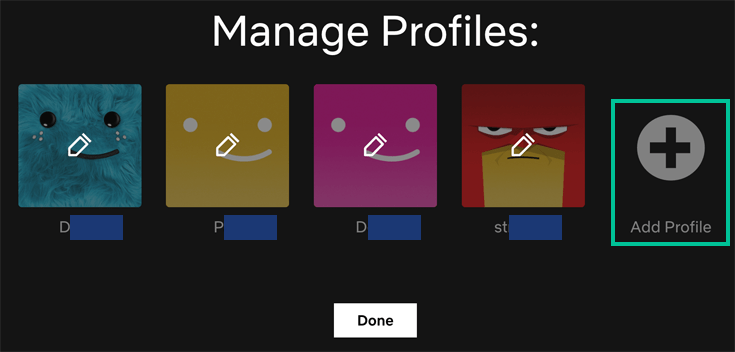
- Fill in the name and all other required details.

- Click on “Done.”
That’s it! The new profile is available in your Netflix account.
How to add a new user to Netflix accounts
If you also want to add a new user (i.e., someone who can log into your account without connecting to your household’s Wi-Fi address), you’ll need to:
- Open your account settings.
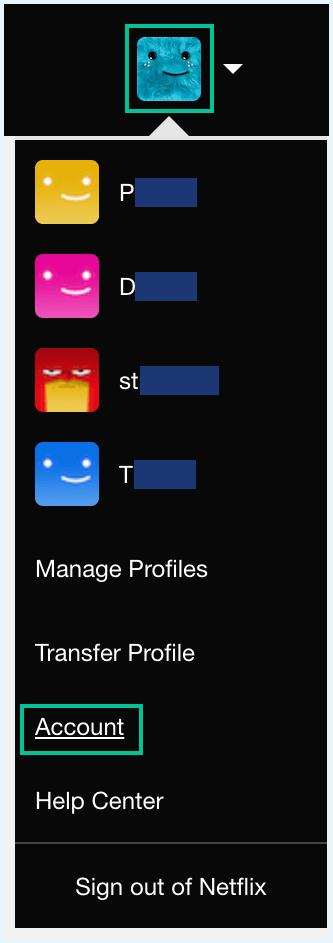
- Scroll down to “Extra Members.”

- Click on “Buy an extra member slot.”
The new member can then use a profile created by the account owner or create a new account for themselves.
How to remove a profile from Netflix accounts
If you want to remove some of the profiles in your Netflix account, here’s what you’ll need to do:
- Open Netflix. As before, we recommend opening Netflix in a browser for managing profiles.
- Open the “Manage Profiles” menu.

- Click on the profile you want to delete.
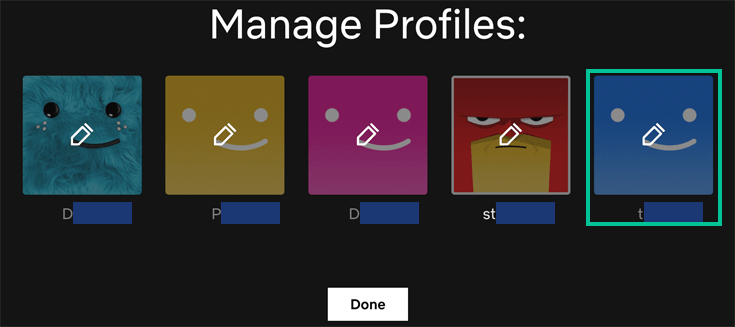
- Scroll to the bottom of the page and click on “Delete Profile.”
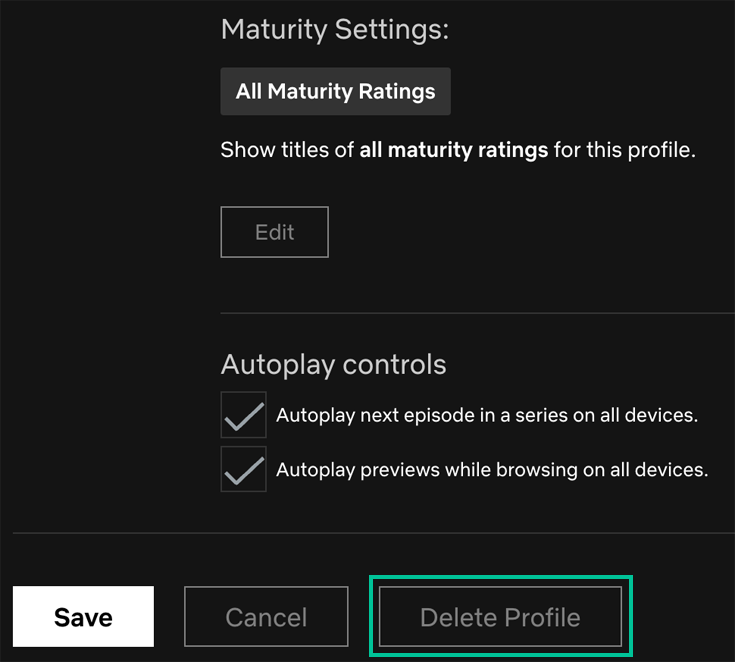
- Confirm your selection.
That’s it! The profile should be deleted now. But this doesn’t mean the person can’t access your account anymore. If you want to log someone out, the easiest way is to change your Netflix password and then log out all other devices.
Final Thoughts: Share Netflix Beyond Your Household
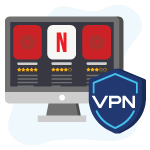
Netflix is cracking down on password sharing. Users all across the world have received emails about it, and they’ll soon have to stop by the account owner’s house if they want to hold on to their profiles.
Fortunately, there’s another way to keep sharing your Netflix subscription. With a Meshnet-capable VPN, users can connect to a household network without being there physically.
According to our tests, NordVPN was the best choice for this purpose. Aside from Meshnet, it has thousands of servers to choose from, fast and reliable connection speeds, and streaming-focused features like obfuscated servers. You can use NordVPN to unblock the Netflix US library and plenty more.
Try NordVPN today with its 30-day money-back guarantee.
Bypassing Netflix Password-Sharing Ban: Frequently Asked Questions
Netflix’s new policy is complex and far-reaching. If you’re still not sure about how it works, and what you can do to bypass the restriction, here is a helpful FAQ section.
Can you use a VPN to get around Netflix password sharing?
Yes, you can use any VPN to get around Netflix password sharing. You just need to connect to the same VPN server as your household. But if you don’t want to restrict yourself to one server, you can use a Meshnet-capable VPN like NordVPN. This will allow you and any device in your household to share the same IP address.
How can Netflix detect password sharing?
Netflix can detect password sharing by tracking the IP address of your network. If your account’s owner connects to Netflix through one IP address, and you connect through another, they’ll be able to tell you’re sharing an account. A good VPN for Netflix can help bypass this issue.
How do I bypass Netflix primary location?
To bypass the Netflix primary location error, you will need to connect to the same network as your household. With a VPN like NordVPN, you can do this remotely.
Can I share my Netflix account with family in a different home?
Not anymore. Netflix recently started to crack down on password sharing between homes. But that doesn’t mean it’s impossible. Users have already gotten creative about circumventing the Netflix password sharing restriction.
Can Netflix password be shared?
Yes, you can share your Netflix password with anyone that lives in the same house as you do. If you want to share your password with people from a different household, you’ll either need to pay for an extra user, or have them connect to your household network every month.
Best VPN

30-day money back guarantee





